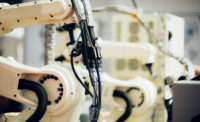By Vladimir Murashov, PhD; Frank Hearl, PE; and John Howard, M.D.
Robots are used in increasing numbers in the workplace and in society in general. As their numbers and capabilities increase, observers have urged that scientists, engineers, and policymakers explore the implications of robotics for society, to ensure that the rise of robots will not spell “doom for humanity” as some critics have warned [1]. To avoid this scenario, in 1942 Isaac Asimov set out three laws of robotics in his short story “Runaround”. The first law of robotics centered on the safety of people states: “A robot may not injure a human being or, through inaction, allow a human being to come to harm.” How well has this law been applied to worker safety as robots take on more tasks in the 21st century workplace and become robot workers? Judging from continuing headlines about workers injured or killed by robots, not sufficiently.
Most recently, a German newspaper (Hessische/Niedersächsische Allgemeine, HNA) reported that a worker, an employee of a third-party contractor, was killed while installing an industrial robot at a Volkswagen assembly line on June 30, 2015 in Baunatal, Germany [2]. The robot gripped and pressed him up against a metal plate, crushing his chest. Despite efforts to revive him, the worker later died at a hospital [3]. It is unclear whether this fatality was caused by engineering error or human error. This case and others of workplace incidents involving industrial robots suggest that additional safety measures for worker interactions with industrial robots are necessary.
Our recently published paper describes the increasing complexity of robots and proposes a number of recommendations for protecting workers interacting with robotic workers [4]. The paper identifies three categories of robots: (1) industrial robots; (2) professional and personal service robots; and (3) collaborative robots. The initial wave of industrial robots were introduced in the 1970s when they began to be used in the manufacturing sector for assembling automobiles. The second robot wave took off at the turn of the 21st century with the introduction of service robots. It was facilitated by the increasing autonomy and sensory capabilities of robots coupled with decreasing cost and size of microprocessor controllers. With the availability of relatively inexpensive collaborative robots capable of working in direct contact with people, we are now entering the third robot wave where robotic workers operate alongside human workers and symbiotic workers, i.e., human workers equipped with performance-enhancing robotic devices such as robotic exoskeletons and other capacity-enhancing prostheses.


